6
State of Design Practice for Stormwater and Graywater
Stormwater and graywater are similar in that they are on-site sources of water that, in many cases, can be used beneficially. However, source conveyance, capture, and distribution for end uses are very different. Although treatment for both water sources is simple at the smallest scales and increases in complexity with scale and degree of human contact, graywater and stormwater pose different treatment concerns. This chapter describes general design principles, the state of practice for graywater and stormwater system designs at household, neighborhood, and regional scales, and treatment that may be used to meet specific end use quality objectives.
OVERALL DESIGN PROCESS
The overall planning and design processes for graywater and stormwater systems (including integrated graywater and stormwater systems) for beneficial use have many similarities. Both start with the identification of project objectives. Chapter 1 outlines a range of objectives that may be associated with on-site graywater or stormwater projects, such as providing a cost-effective alternative water supply, diversifying the water portfolio, reducing runoff volume and peak flows, reducing downstream pollutant loads, and conserving water and energy resources. In addition to the overarching project objectives, additional design objectives may drive major choices in system configuration (some common design objectives are included in Table 6-1). It is important to consider all project objectives when deciding whether and how to design a beneficial use project.
Figure 6-1 outlines the general steps for the progression of project design, beginning with overall objectives for the beneficial use project. The quantity, quality, and timing of available on-site water supplies (see Chapters 3 and 4) then need to be assessed. The basic feasibility of beneficial use projects can be determined by comparing the available quantity with the anticipated demands, considering the possible water use applications (see Chapter 2). Major mismatches in the quantity or timing of supply and demand suggest that the project may not be appropriate or cost-effective for the site conditions. Once general feasibility is determined, system design alternatives for graywater or stormwater capture, storage, and treatment can be considered and evaluated based on their cost, other benefits provided, and the extent to which the project achieves its objectives. Unit processes within the treatment train (if applicable) would be selected based on factors such as water quality objectives, cost, maintenance requirements, and project scale. Figure 6-1 outlines the design-related steps within the broader decision framework for a project, discussed in Chapter 9.
The following sections discuss system design considerations for the beneficial use of graywater and stormwater. Unit processes for graywater and stormwater capture and use systems are discussed at the end of the chapter.
GRAYWATER SYSTEM DESIGN
Typical graywater systems are designed to supply water for irrigation and/or toilet flushing. A key factor is matching the graywater supply with demand so that the resource is managed efficiently. Approaches to estimate graywater demand are summarized in Bergdolt et al. (2011). Table 6-2 summarizes some key considerations for graywater project design across different scales. Graywater generation in multi-residential buildings may often be greater than can be effectively used for irrigation, while commercial or industrial buildings may not generate enough to meet specific needs. The following sections outline the state of practice for graywater use at the household or neighborhood scale.
Collection and Storage
Graywater collection requires separate collection of graywater sources (i.e., showers/baths, lavatory sinks, and laundry) from blackwater (i.e., toilet and kitchen water). In conventional homes, graywater sources are combined with
TABLE 6-1 Examples of System Design Objectives Relevant to On-site Use of Graywater or Stormwater
| Category | Typical Design Objectives |
| Regulatory | Meet local, state, or federal requirements |
| Cost | Minimize capital, operation, and maintenance (life-cycle) costs or achieve lower unit costs than alternative water supplies |
| Aesthetic and public perception | Improve appearance and public perception of a site |
| Contribute to positive environmental action | |
| Maintenance | Operate within maintenance and repair schedule and requirements |
| Design systems to allow for modification or expansion | |
| Longevity | Achieve long-term functionality |
| Resources | Improve downstream aquatic environment |
| Improve wildlife habitat | |
| Achieve multiple use functionality | |
| Safety, risk, and liability | Function without significant risk or liability |
| Function with minimal environmental risk downstream |
SOURCE: Adapted from TRB (2006).
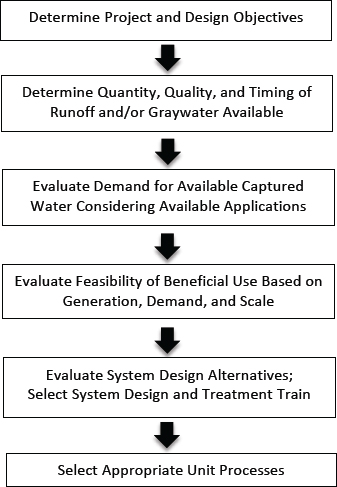
blackwater sources very near to plumbing fixtures. Where graywater is reused, separate pipes are installed for graywater collection from fixtures to divert graywater to a treatment and/or use system (Figure 6-2). Guidance on collection and use of graywater for both irrigation and toilet flushing is included in Bergdolt et al. (2011).
In existing one-story homes with an unfinished basement or crawl space, graywater collection can be accomplished fairly simply. However, in most existing homes, retrofits for separate collection of household graywater are too costly to justify unless conducted as part of a major home remodeling effort. Simple laundry-to-landscape systems with no storage are often installed in existing development, and many homeowners can build this simple, low-cost system themselves. New development projects, however, can consider separate collection of household graywater, and graywater may even be collected and treated at a neighborhood (multi-residential) scale (see Figure 2-1). Neighborhood-scale graywater reuse removes the burden of maintenance from the homeowner and enables centralized quality assurance inspections to ensure that the system is meeting water quality requirements. The two basic graywater systems are discussed below, followed by discussions of treatment considerations.
Laundry to Landscape
A simple design for graywater irrigation systems is the laundry-to-landscape system (Figure 6-3), which is typically applied only at the household scale. This system does not require storage or filtration and has been applied at many households. Laundry water is pumped directly from the washing machine to valve boxes submerged in mulch basins. The water is then conveyed for subsurface irrigation into tree trenches or mulch basins or through subsurface irrigation to minimize human contact. Mulch basins include drip irrigation systems below ground surface covered with mulch. Many states and the 2012 Uniform Plumbing Code recommend that drip irrigation systems be covered by at least 2 inches (5 cm) of mulch to reduce human exposures (see Chapter 8, Box 8-1). Many states also provide guidance on graywater application rates based on soil type to ensure adequate infiltration of graywater and minimize build-up of salt in clay soils. Pumps internal to laundry machines provide sufficient pressure to distribute graywater through these systems. Homeowners have generally been satisfied with laundry-to-landscape systems and have not noted excessive maintenance issues (Box 6-1 and Box 2-4). In climates where freezing temperatures are observed in winter months, graywater is diverted to a wastewater collection system for those months to prevent breaks in the distribution plumbing.
Graywater Systems with Storage
Beyond the most simple laundry-to-landscape systems, graywater systems that collect water from multiple sources (e.g., laundry, shower, handwash basins, and bath tubs) need to include a storage tank (Figure 6-4). Storage tanks must be well sealed and include a vent and an overflow and drain to a wastewater collection system. The 2012 International Plumbing Code (IPC), which has been adopted by some
TABLE 6-2 Design and Feasibility Considerations Specific to Household, Neighborhood, and Commercial and Industrial Applications of Graywater Beneficial Uses
| Household | Neighborhood/Multi-residential | Commercial and Institutional | |
| Irrigation |
|
|
|
| Toilet Flushing |
|
|
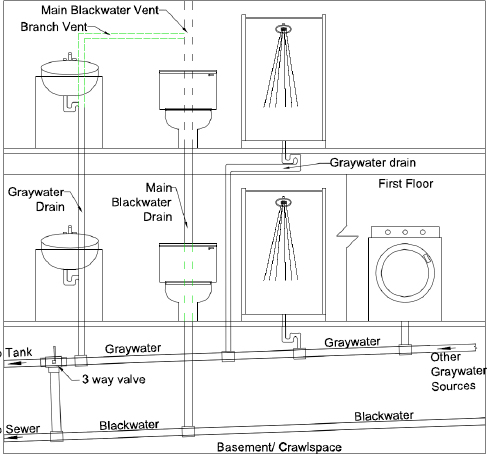
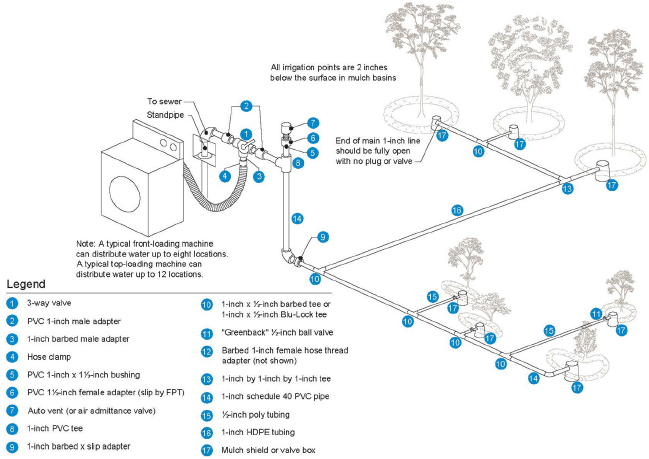
states,1 specifies a maximum graywater storage time of 24 hours for irrigation and 48 hours for toilet flushing. Thus, storage tanks are designed based on expected graywater generation such that graywater not used in a 24-48 hour period will overflow to a wastewater collection system. Guidance for design and sizing of storage tanks is provided in Bergdolt et al. (2011). Storage tanks act as a settling tank for large particles (e.g., lint and hair) present in graywater. Therefore, the graywater in storage tanks should not be mixed to avoid re-suspension of previously settled materials.
Graywater irrigation systems with storage also include a coarse filter and pump (Figure 6-4; Bergdolt et al., 2011). Coarse filters should be selected based on specifications provided by the manufacturer of drip supply lines and will typically be around 120-150 mesh (110-125 µm). When graywater is used for toilet flushing, a separate contact tank is recommended for disinfection. Water is drawn as needed from the storage tank and then diverted to the disinfection tank. The technology is mature, and commercially available kits to install graywater irrigation systems may increase adoption of the practice.
Graywater Treatment Design Considerations
The extent and type of graywater treatment system depends on the end use for graywater. The following section outlines basic treatment design considerations for various end use graywater applications.
Subsurface Irrigation
When human exposures to graywater are minimized (e.g., subsurface irrigation), minimal treatment is required (see Chapter 5). The simple laundry-to-landscape design, where untreated graywater is supplied at least 2 inches below the ground surface, is allowed in many of the states that allow graywater use for irrigation. Among the 25 states that currently allow household-scale graywater use for irrigation (see Chapter 8), 20 states have not established enforceable water quality requirements for subsurface irrigation at the household scale. Instead, common sense best management practices are provided to guide safe application of graywater for irrigation (Sharvelle et al., 2013). In such states, laundry-to-landscape systems with no treatment (Figure 6-3)
__________________
1 See http://www.iccsafe.org/gr/Documents/stateadoptions.pdf.
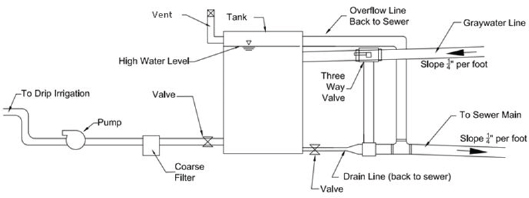
SOURCE: Bergdolt et al. (2011).
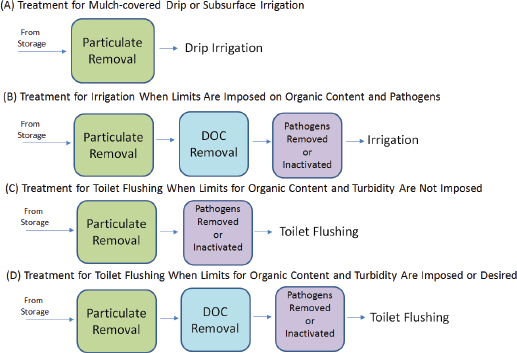
or simple graywater systems with storage and particulate removal (Figures 6-4 and 6-5a) are typically used. Filtration is necessary when a conventional drip irrigation system is used for graywater to prevent clogging (Figure 6-5a). Graywater systems without disinfection are appropriate where exposures are restricted by subsurface irrigation systems. The additional risks associated with graywater applied by surface irrigation (not covered by mulch) at the household scale are less clear, because pathogen data for graywater are extremely limited. Additionally, graywater is only one of many existing vehicles of infectious disease transmission already present within the household (see Chapter 5). Potential risks, therefore, increase with exposures to untreated graywater at neighborhood and regional scales, because graywater provides a new vehicle for disease spread between people that might not otherwise be in contact.
Only four states impose water quality standards for subsurface irrigation at the household scale (Table 6-3). The states of Wisconsin and Maine have set indicator organism limits as part of their irrigation water quality requirements (Table 6-3). Based on typical graywater quality (see Chapter 4; Table 4-1), disinfection is required in those states that impose limits on indicator organisms for subsurface irrigation. Organic carbon or solids removal for single residence irrigation is required in five states that currently allow graywater irrigation (Table 6-3). In those states, requirements for organic carbon (often measured as 5-day biochemical oxygen demand, BOD5) and total suspended solids (TSS) are well below typical amounts found in raw graywater. Thus, a treatment system would be required in these states to remove organic carbon and solids (see Figure 6-5b). Because organic carbon in graywater occurs primarily in the dissolved form
(i.e., from personal care products), more extensive treatment is required to remove dissolved organic carbon (DOC) compared to stormwater, where organic carbon is often in the particulate form and can be removed through sedimentation and filtration. For graywater, biological or physicochemical treatment systems (discussed later in the chapter) are required to remove DOC if BOD5 concentrations of less than or equal to 30 mg/L are desired. Graywater systems that employ the treatment processes identified in Figure 6-5b are most appropriate at the neighborhood scales or larger because of the complexities of system components that remove dissolved organic matter. Current regulations addressing organic matter in subsurface irrigation may be overly conservative. Research conducted by Sharvelle et al. (2012) showed that such treatment is not required for successful operation of subsurface irrigation systems that use graywater.
Some basic treatment systems are outlined in Figure 6-5, where the contaminants of concern for removal include suspended solids, pathogens, and in some cases DOC. One other water quality concern for graywater treatment is odor. Graywater can become odorous after it is stored for several hours in an anaerobic environment. Storage tanks, as shown in Figure 6-4, must be properly sealed and vented to direct odorous emissions to an appropriate location, preventing odor buildup in the building.
Toilet Flushing
Further treatment is necessary to reduce human health risks when graywater is used to flush toilets because of potential human exposures to pathogens present in untreated graywater (see Chapter 5). All states with graywater regulations that address toilet flushing require disinfection, and seven states have laws that set specific water quality requirements for toilet flushing (Table 6-4). Wide variability exists in these state regulations in terms of target concentrations
TABLE 6-3 State Water Quality Standards for Residential Graywater Irrigation Through Surface Drip and Subsurface Systems
| BOD5 (mg/L) | TSS (mg/L) | Maximum Total Coliform (cfu/100ml) | Maximum Fecal Coliform (cfu/100ml) | |
| Florida | 25 | 30 | - | - |
| Georgia | 30 | 30 | - | - |
| Wisconsin | 30 | 35 | - | 200 |
| Maine | 30 | 10-30 | 10-100 | - |
| State water reuse regulations for restricted access urban reuse | 10-60 | 5-60 | 240a | 23-800a |
| Reported range of typical graywater prior to treatmenta | 30-380 | 50-280 | 500-630,000 | 40-7,900 |
aSee Table 4-1 for data sources; includes single fixture graywater and combined sources (not including the kitchen sink or dishwasher). E. coli reported for fecal coliform, which represents only one of the fecal coliform indicator bacteria that may be present.
NOTES: Approximately 20 states allow household-scale graywater irrigation with no water quality standards. Florida, Georgia, and Wisconsin standards apply to subsurface irrigaton only.
SOURCES: Sharvelle et al. (2013); EPA (2012a).
TABLE 6-4 State Water Quality Standards for Graywater Reuse for Toilet Flushing
| BOD5 (mg/L) | TSS (mg/L) | Turbidity (NTU) | Total Coliform (cfu/100 ml) | Fecal Coliform (cfu/100 ml) | Disinfection | |
| California | - | - | - | 2.2a | - | - |
| New Mexico | 30 | 30 | - | - | 200 | - |
| Oregon | 10 | 10 | - | 2.2a | - | - |
| Georgia | - | - | 10 | 500b | 100b | - |
| Texas | - | - | - | - | 75b | - |
| Massachusetts | 10 | 5 | 2 | - | 14b | - |
| Wisconsin | 200 | 5 | - | - | - | 0.1-4 mg L-1 residual chlorine |
| State Water Reuse Regulations for | 5-60 | 5-60 | 2-10 | 2.2 (mean) | 2.2-14 (med. or mean) | - |
| Unrestricted Access Urban Reuse | 23-240 (max.) | 14-200 (max.) | ||||
| Reported range of typical Graywater prior to treatmentc | 30-380 | 50-280 | 30-240 | 500-630,000 | 40-7,900 | N/A |
aMedian value.
bDaily or sample maximum
cSee Table 4-1 for data sources; includes single fixture graywater and combined sources (not including the kitchen sink or dishwasher). E. coli reported for fecal coliform, which represents only one of the fecal coliform indicator bacteria that may be present.
SOURCES: Sharvelle et al. (2013); EPA (2012a).
for indicator organisms. The state of Wisconsin has simplified the issue by requiring a target range for residual chlorine rather than indicator organism targets (Table 6-4). Disinfection processes are also important to control odor, although treated graywater can become odorous when residual disinfectants are not maintained (Vandegrift, 2014).
Additional removal of DOC (often measured as BOD5) and TSS or turbidity is required in some states for toilet flushing with graywater, although little research is available to clarify whether or how much DOC removal is necessary. Although a small portion of organic matter can be removed through sedimentation or other processes for particulate removal, much of the organic matter in graywater is in the form of DOC. Even extensive removal of DOC in graywater, resulting in measured BOD5 concentrations between 5-10 mg/L, would not prevent regrowth of pathogenic organisms. Instead, disinfectant residual must be maintained to prevent regrowth of pathogens. Research has demonstrated that when adequate concentrations of residual total chlorine are achieved, regrowth of indicator organisms can be prevented for 3-4 days even when DOC is not removed from graywater during treatment (Wiles, 2013). Nevertheless, DOC or turbidity removal allows residual disinfectant concentrations to be more reliably maintained. When residual disinfectant levels are not maintained, it is possible for biofilms to form in distribution systems that could contribute to the microbial load in treated graywater. Thus, treatment with DOC removal in addition to disinfection (Figure 6-5d) is generally recommended at neighborhood or regional scales. Many commercially available systems for household-scale treatment of graywater are not designed to remove DOC, which may be acceptable as long as disinfectant concentrations are adequately maintained (Sharvelle et al., 2012). In these systems, disinfection residuals are often achieved via chlorine addition, with the potential concern associated with the formation of disinfection by-products. When treated graywater is used for toilet flushing, the ultimate fate of those disinfection by-products is a wastewater treatment system, where they may or may not be removed from the water depending on treatment practices. Many treatment technologies are available to meet the desired water quality objectives, and these unit processes are discussed later in the chapter.
Commercial graywater treatment systems for toilet flushing vary substantially in complexity and the degree of treatment achieved. Those systems that achieve a high degree of treatment are generally too expensive for current widespread adoption at the household scale, and there are reliability issues with systems that are more cost-effective. Some providers of graywater treatment systems have gone out of business in the past few years (e.g., Brac and Water Legacy), and maintenance issues have been cited as a cause for such failures. As of 2015, only two treatment systems have achieved National Sanitation Foundation (NSF) International 350 certification for toilet flushing2 because of the extensive treatment required to meet the certification (see Box 6-2). In particular, the standards set for carbonaceous biochemical oxygen demand (CBOD) and turbidity in NSF 350 are difficult to achieve with simple treatment systems, such as sand filtration or cartridge filters (Friedler et al., 2006; Gual et al., 2008; Hodgson, 2012; Zuma et al., 2009). Even ultrafiltration membranes were not found to achieve CBOD less than 10 mg/L when applied to graywater (Ramon et al., 2004). To achieve the CBOD and turbidity requirements outlined in NSF 350, graywater must be treated through a biological reactor, membrane filtration (nanofiltration or reverse osmosis), or activated carbon, all of which are technologies that have not previously proven to be practical for residential application because of complexity and associated high costs and maintenance. Some of these technologies become more cost-effective and practical at the neighborhood scale, although one company recently launched a graywater treatment system for household use meeting NSF 350 standards (Showley, 2015).
In the committee’s judgment, NSF 350 (see Box 6-2) requires more extensive treatment than necessary to provide safe water for flushing toilets, and use of this standard as a basis for toilet flushing could increase project costs, unless novel technologies are developed. Additional research is needed to better understand the impacts on risk and reliability associated with higher organic matter and turbidity levels in graywater for toilet flushing at a range of scales, because these factors significantly affect treatment costs. This research could inform the development of improved risk-based guidance that could provide the basis for standards of practice.
Spray Irrigation
If graywater is to be used for spray irrigation, then it must meet state water quality requirements for unrestricted use of reclaimed wastewater, which are summarized in Table 6-4 and detailed in EPA (2012a). Generally, the regulations require BOD5 of less than 20-30 mg/L and very low numbers of indicator organisms (i.e., less than 23/100 mL total coliforms in California). Treatment of graywater for spray irrigation would require removal of organic matter and disinfection (Figure 6-5b), using treatment processes similar to those used for toilet flushing. Given the treatment costs and maintenance required, these systems are generally recommended at neighborhood and municipal scales, but not at the household scale.
__________________
Consideration of Scale for Selection of Appropriate Treatment Processes
The most important drivers for selection of appropriate technology for graywater treatment processes are to achieve quality appropriate for the desired end use and to meet water quality requirements. However, another important consideration is the scale of the system.
Household Scale. Untreated graywater is commonly applied for irrigation at the household scale (Sharvelle et al., 2012). There is some level of complexity in all treatment processes applied for toilet flushing (Figures 6-5c and 6-5d). Although technologies are commercially available that implement these treatment processes at the residential scale (particularly in Australia; Sharvelle et al., 2013), they typically require substantial homeowner maintenance. Adoption of household-scale treatment systems that include the treatment steps outlined in Figures 6-5c or 6-5d has been limited in the United States because the maintenance required is generally not practical for most homeowners. The treatment processes identified in Figure 6-5c with only suspended sediment removal and disinfection are more likely to be adopted at the residential scale than are those in Figure 6-5d, where DOC is also removed from graywater. DOC and turbidity remaining in treated graywater cause some aesthetic issues that may be acceptable to individual homeowners who want to use graywater for toilet flushing.
Neighborhood and Regional Scale. Large-scale graywater systems for irrigation can be put in place in multi-residential and commercial facilities (Table 6-2). If untreated graywater is applied through subsurface irrigation systems so that human exposures are prevented, then the simplest treatment processes for graywater that include storage and coarse filtration (Figure 6-5a) are still acceptable and appropriate. However, in multi-residential and/or commercial systems, more complex treatment can be considered when staff are available to maintain the system. This allows for a higher degree of treatment and the potential to use the treated graywater for spray irrigation in addition to subsurface drip irrigation. The current standard of practice is that disinfection is conducted for neighborhood-scale graywater systems (Figure 6-5b, with or without DOC removal).
For toilet flushing at neighborhood or regional scales, DOC removal in addition to disinfection is often adopted to reduce turbidity and associated public concerns regarding water quality (Figure 6-5d). In addition, at the multi-residential scale, typically staff are available to perform routine maintenance activities (Box 6-2), rendering such treatment processes more practical than at the household scale. Multi-residential units can be a very good fit for graywater use for toilet flushing because of the reliable source of graywater and ease of collection and redistribution to toilets. In addition, economies of scale are realized and maintenance can be feasible.
Graywater System Operational Considerations
From the simplest laundry-to-landscape graywater system to the treatment processes identified in Figure 6-5, all systems require maintenance that is critical to sustain safe graywater operations. The degree of maintenance required depends on the complexity of the system to be installed. Maintenance for graywater systems typically includes activities such as changing and/or cleaning filters, replacing consumables, and replacing system components when they reach the end of their useful life. At the household scale, the burden of maintenance falls on the homeowner; thus, more success has been reported for systems that are very simple and require low maintenance. At the neighborhood scale, routine maintenance can be conducted by facilities staff or a homeowners association.
For simple graywater irrigation systems (e.g., laundry-to-landscape or the treatment system in Figure 6-5a), lack of maintenance typically results in the inability to operate the system and irrigate landscape, with limited risk to human health. However, when water quality goals are in place and the potential for human contact with graywater is high (e.g., toilet flushing or spray irrigation), lack of proper maintenance can result in human health risk, and routine monitoring is necessary to ensure safe operations. Thus, advances in online monitoring and automations would enable practical application of household graywater systems that achieve a high level of treatment (i.e., removal of organic matter and turbidity and disinfection) and thereby expand the potential use of graywater at the household scale.
Chlorine residual is an easily monitored parameter and a good indicator of the safety of treated graywater. Chlorine can be monitored online or with simple test kits. An example of online chlorine monitoring is at Aspen Residence Hall at Colorado State University (see Box 2-2) where the system automatically switches to municipal water supply when the residual chlorine concentration in treated graywater (collected directly after the treatment system) drops below 1.0 mg/L.
Energy Recovery from Graywater Systems
Heat from graywater can be captured through heat exchange systems to save energy. Graywater temperature ranges from 64 to 100oF (18-38oC; Ericksson et al., 2002), and sources of graywater tend to be heated water (e.g., showers, baths and laundry). Several studies have demonstrated the capacity to recover energy from graywater, with energy requirements of potable water heating reduced by up to 30-50 percent (Proskiw, 1998; McNabola and Shields, 2013; Smith, 1975), although the largest recoveries are possible closest to the drain point of the hot water. The heat recovered from graywater can be used for heating potable water or to improve the efficiency of absorption heat pumps.
Eliminating graywater from the wastewater stream increases concentrations of solids and organic matter compared to domestic wastewater, making it amenable to anaerobic treatment and enhanced energy recovery (Liu et al., 2004; McCarty et al., 2011). An example is a system designed by Semizentral under implementation in Qingdao, China (Semizentral, 2015), which is designed for a population of 12,000 and started in 2012 (see Box 2-1).
SYSTEM DESIGN FOR STORMWATER BENEFICIAL USE
The design of systems for beneficial uses of stormwater (Figure 6-1) results from careful consideration of available design alternatives to meet a complex web of often competing objectives. In contrast with graywater project planning, regulatory drivers are frequently the top priority when establishing stormwater-related project objectives. Often, several different regulations must be met for any given project. Stormwater regulations may dictate hydrologic, hydraulic, water quality, or design objectives. In many cases, regula-
tions are highly prescriptive in how to design stormwater controls as well as directly govern the design process for beneficial use systems. The most common regulatory drivers that cause stakeholders to implement stormwater capture and use systems include the following:
- Combined sewer overflow regulations and associated standards for retaining certain rainfall depths on site,
- Total maximum daily load (TMDL) implementation plans,
- National Pollutant Discharge Elimination System Phase I and Phase II permit conditions,
- State regulations including water quality and design standards,
- Potable water use restrictions (e.g., during times of drought), and
- Local regulations (e.g., requiring or strongly motivating onsite use).
Stormwater beneficial use systems can be developed at many different scales, from household rain barrels and cisterns to neighborhood-scale stormwater collection to regional capture and infiltration systems to augment municipal water supplies (see Chapter 2). Regardless of scale, design for stormwater capture and use projects includes assessments of the quantity of runoff available from the source area and water quality relative to intended uses, as well as decisions on runoff conveyance, storage, treatment, and water delivery to meet the overall objectives. Many useful guidebooks exist to advise homeowners on how to design systems to capture rooftop runoff for on-site use (Carpenter et al., 2009; City of Bellingham, 2012; Despins, 2010; Jones and Hunt, 2014; Lawson et al., 2009; MPCA, 2015). The following sections describe typical approaches to storage and treatment for stormwater capture and use across a range of relevant scales, focused on two distinct strategies: (1) stormwater capture and tank storage and (2) groundwater recharge.
Stormwater Capture and Tank Storage
The capture and on-site storage of stormwater for later withdrawal and use, sometimes called “active” stormwater harvesting, can be designed across a range of scales, from households to large buildings to neighborhoods.
Stormwater Capture at Household and Single-Building Scales
Capture, Storage, and Distribution. Rooftop runoff can be readily captured at the household or large-commercial-building scale for a range of beneficial uses. Irrigation is the predominant use for household-scale projects, although large tanks could provide water for nonpotable indoor uses (e.g., toilet flushing) or commercial applications (e.g., cooling, washing, laundry [see Chapter 2 and Box 6-3]). Roof area and climate determine the quantity and timing of stormwater runoff available for beneficial use (see Figure 3-2).
Tank size determines how much of the available stormwater can be captured for beneficial use. Storage tank capacities can range from small containers, such as rain barrels that are about 35 gallons (130 liters) each, to large surface or subsurface tanks (Figures 2-1, 6-6, and 6-7). Rain barrels are most commonly used at residential properties and are a component of many public education programs. Large above-ground tanks are often made of corrugated metal, precast or cast-in-place concrete, or polyethylene plastic. Below-ground tanks are commonly made of precast concrete, plastic pipe, fiberglass reinforced plastic, or proprietary modular plastic storage systems surrounded with impermeable geotextile membranes (Figure 6-7).
Rain barrels provide a small supplemental water supply and typically only capture a small fraction of roof runoff on an annual basis, even in arid climates, while larger tanks have been used to store substantial fractions of roof runoff for beneficial uses (see Chapter 3). The committee’s scenario analysis of stormwater irrigation use in Chapter 3 based on 1,500 ft2 (140 m2) roof areas and medium-density residential development showed that two rain barrels captured and enabled the irrigation use of between 5 and 14 percent of roof runoff in the six locations analyzed, compared to between 16 and 61 percent for large 2,200-gallon (8,300 liters) cisterns, with the magnitude of capture depending on local rainfall patterns relative to on-site water demand (see Table 3-7). The larger cisterns provided 4 to 21 percent potential potable water savings in total water use in the committee’s irrigation use scenario analysis, compared to 1 to 5 percent for two rain barrels per house (see Tables 3-5 and 3-6). Table 6-5 provides an example highlighting the different levels of performance achieved, in terms of reducing stormwater runoff, by larger storage tanks for a research site in Kansas City for roofs about 1,000 ft2 (92 m2) in area (Pitt et al., 2014). As tank size increases, fewer rain events are likely to overfill the tank, assuming the captured water is effectively used to match the evapotranspiration demand, and a larger percentage of the on-site stormwater is also be available for use. Larger tanks are common in Australia and New Zealand at homes where they supply much of the household nonconsumptive water requirements and, in some cases, provide drinking water (Cunliffe, 2004).
Sizing appropriate storage for household- or building-scale use requires a careful assessment of the quantity and timing of on-site water demand (e.g., irrigation, toilet flushing, other uses) relative to the quantity and timing of rooftop
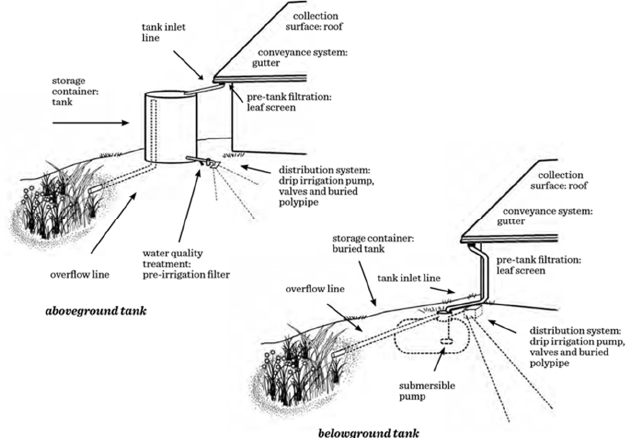
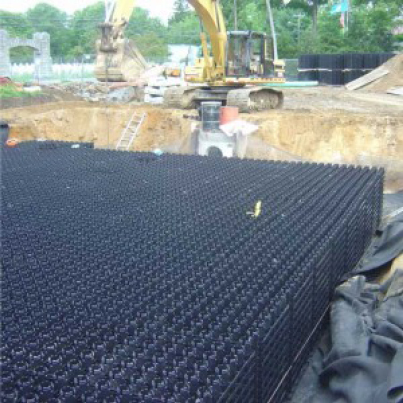
runoff available in the context of overall project objectives. The relative importance of water supply versus stormwater runoff control will also influence the optimal project design. Larger tanks provide larger capture and allow less stormwater runoff, but if on-site use does not keep pace with availability, even large tanks can eventually fill, which negates their hydrologic and pollution reduction benefits. Depending on precipitation rates and timing relative to on-site use, a threshold can be met where increasing tank size does not provide additional benefits. This is particularly true in areas with abundant precipitation, such as the central or eastern United States. In the Southwest, where rainfall and irrigation demand are mismatched, extremely large tanks (approximately 20,000 gallons for a 1,500 ft2 roof in a medium-density, residential development; see Figure 3-11) would be needed to capture all of the available roof runoff, and the runoff would still not meet the total irrigation demand (see Chapter 3). Costs are also a significant factor in determining the appropriate size of storage (see Chapter 7).
The elevation of the roof area and existing gutters can typically provide passive conveyance to storage tanks (see Figure 6-6). Ideally, tanks are located at a high point on the property, so that gravity can be used to distribute the rainwater as needed, although pumps can also be added for increased water pressure.
All storage tanks need to be sealed and screened to prevent mosquito issues. Rector et al. (2014) describe additional design and maintenance suggestions to prevent mosquitoes from entering and breeding in stormwater storage tanks.
Treatment. Roof runoff usually has the best water quality of the source flows in urban areas, which reduces the need for extensive water treatment. If the captured runoff is to be used untreated, then care should be taken to minimize contamination by avoiding materials that release high levels of metals into the water (see Box 4-1) and avoiding collection from shaded roof areas, because the tree cover can serve as habitat for urban wildlife and increase bacteria loading to the
TABLE 6-5 Storage Tank Sizes for Different Ranges of Captured Runoff from a 1,000 ft2 Residential Roof Area in Kansas City, Missouri
| Storage Volume (ft3) |
Storage Volume (gal.) |
Approximate Annual Roof Runoff Captured (%) |
Number of 35 gal Rain Barrels Needed |
Number of 5-ft-diam., 5-ft-tall tanks |
Number of 10-ft-diam., 10-ft-tall tanks |
| 10 | 75 | 20-30 | 2 | 0.1 | NA |
| 30 | 224 | 45-60 | 6 | 0.3 | NA |
| 100 | 748 | 80-90 | 21 | 1 | 0.1 |
| 300 | 2,244 | 98-100 | 64 | 3 | 0.4 |
| 500 | 3,740 | 99-100 | 107 | 5 | 0.7 |
| 1,000 | 7,480 | 100 | 214 | 10 | 1.3 |
NOTE: A 5-foot-diameter, 5-foot-tall tank represents 730 gallons of storage or 98 ft3. A 10-foot-diameter, 10-foot-tall tank holds 5,900 gallons or 785 ft3.
SOURCE: Pitt et al. (2014).
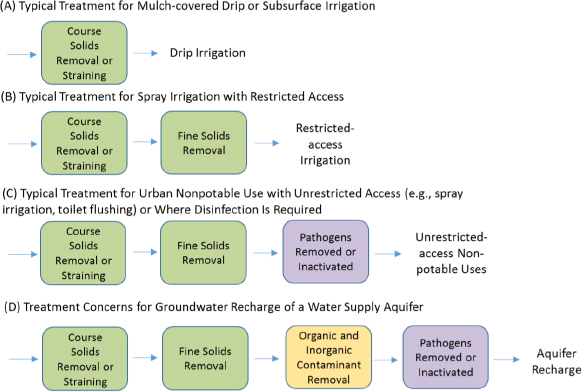
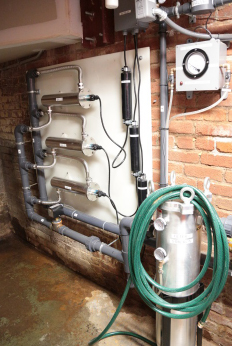
roof runoff. When source control is combined with applications that minimize human exposures, such as drip irrigation or restricted access to a spray-irrigated site, no treatment is needed other than removal of suspended solids to prevent clogging (see Figures 6-8a and 6-8b; see also Chapter 5). In all cases, some type of coarse filter is usually installed in the intake line to prevent organic leaf debris from entering the storage tank. In addition, many household roof harvesting systems use “first-flush” diverters to direct the more contaminated initial runoff from the roof away from the storage tank, although there is little evidence to show the effectiveness of these first flush diverters. To reduce fine solids and minimize problems with sprinkler head clogging, a simple sand or cartridge filter can be used in-line with the pressurized line.
For applications with significant human exposures, risk-based stormwater treatment design is complicated by limited data on the occurrence of human pathogens in stormwater at a range of scales and source areas. With site-specific pathogen data (reflecting multiple samples over a single year), the risk assessment framework outlined in Chapter 5 can be used to assess whether treatment is needed. In absence of these data, a typical conservative approach bases the treatment design on known or estimated concentrations of fecal indicator bacteria; but these may be poor indicators of the presence or concentrations of human pathogens in roof runoff (see Chapter 5). Roof runoff may contain elevated fecal indicator bacteria, particularly if trees with urban wildlife (especially birds and squirrels) are close, as is common in residential areas. In some cases, the levels of indicator bacteria may decrease because of die-off during storage in the tank, but die-off is not consistent, and concentrations may even increase with storage (Pitt and Talebi, 2012b). Therefore, if bacteria reduction is necessary to ensure safe operations in areas where access is not controlled and significant exposures are possible (or to meet regulatory requirements), then disinfection will be necessary (Figures 6-8c and 6-9). An array of unit processes are available to maintain bacteriological quality (discussed later in the chapter), but historically, chlorine has been used for small-scale installations. With an adequate recirculating pump system, it may be possible to maintain bacteriological quality in the tank without high chlorine residuals.
Maintenance. Periodic maintenance of stormwater capture systems is essential to their appropriate function and safe use. Maintenance needs at the household or building scale are relatively low and mostly related to periodic removal of sediments that enter the tank as well as any routine maintenance for any treatment systems (e.g., clean or replace filters) or mechanical systems (e.g., pump, first flush diverter) used. These tasks can be performed by the homeowner or a contractor. However, utility- or community-based inspection and maintenance programs could be developed to ensure robust maintenance, cost-effective operation, and low risks to human health. Such rigorous maintenance efforts would be necessary if the household capture of roof runoff was part of a regional water supply strategy.
Stormwater Capture and Tank Storage at Neighborhood Scales
Capture, Storage, and Distribution. Neighborhood-scale stormwater capture projects may use roof runoff from several close buildings, such as at institutions or business parks, or collect mixed stormwater flows originating from several source areas (e.g., roofs, paved surfaces) located close together, allowing a larger percentage of total runoff to be captured. The most common situation is collecting at-grade surface flow from parking lots and roadways. Subsurface water storage tanks are often used in neighborhood-scale stormwater collection systems and come in a range of designs, from traditional tanks to large subsurface storage units (see Box 2-5 and Figure 6-7). In Docklands Park in Melbourne, Australia, subsurface tanks hold approximately 130,000 gallons of stormwater runoff collected from the surrounding urban area for irrigation use (see Box 6-4).
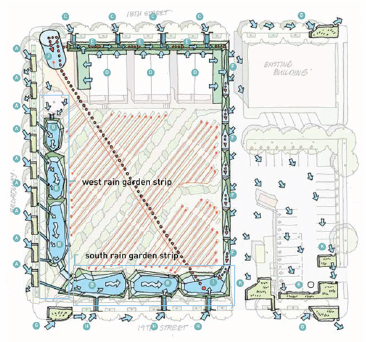
Larger neighborhood-scale systems frequently require extensive piping and pumping systems, because it is rarely the case that gravity drainage can provide adequate collection of runoff from disparate site areas to a central storage location. For these reasons it is advisable to integrate plans for the beneficial use of stormwater into site-development planning as early as possible such that long-term energy costs and infrastructure maintenance can be minimized. This can be challenging because these considerations are not typically included as driving factors in site design. When assessing the costs and benefits of such systems, one may find that some of the economies of scale derived from neighborhood systems are offset by increased energy costs and infrastructure complexity. In these cases, it is worth considering distributing storage around a site and utilizing transfer pumps to move water as needed to a central storage and treatment system. The National Park Service used this approach in retrofitting the National Mall in Washington, DC, with approximately 1 million gallons of total storage for on-site irrigation use (Box 2-5). The National Park Service designed a set of large distributed collection tanks that feed to a single central storage tank that then is used for treatment and distribution.
At the neighborhood or large-building scale, real-time, logic-controlled release of captured stormwater can be used to optimize water conservation and meet water quality objectives. These operations are usually designed as part of combined sewer overflow and stormwater management activities and discharge captured stormwater based on predictions of the amount of runoff for a coming rain. This approach keeps the maximum amount of water in the tank for beneficial uses when needed, while ensuring that sufficient storage is available to retain the water from the upcoming storm. During operations before a predicted storm, a remote-operated computer system checks the tank water volume to ensure that sufficient storage volume is available to contain the expected runoff volume for the next rain. If insufficient volume is available, then the tank is drained to allow capture of the next event. Between events, the water in the tank is available for whatever beneficial uses are suitable (WERF, 2014).
Low-cost, programmable logic controller systems are now available and can be coupled with wired and wireless internet communications and low-cost sensor systems for both new construction and retrofits of stormwater storage systems. The commercial availability of highly distributed real-time control (DRTC) technologies first became available around 2013. The use of DTRC systems in stormwater harvesting is particularly compelling because they have been
shown to significantly enhance the performance of stormwater capture when internet-based forecast data are effectively integrated into control logic (WERF, 2005). Real-time systems result in lower overall water savings (based on releases for forecasted storms that do not occur), but they offer notable advantages when water quality or wet weather flow objectives are also important.
Treatment. Runoff from the non-roof areas that drain into most neighborhood-scale stormwater capture systems is often of poorer quality than roof runoff (see Chapter 4) and therefore requires significant pre-treatment prior to storage. This pre-treatment can be integrated into site design to utilize natural treatment systems such as biofiltration or bioretention to reduce sediment and other contaminant loading to a beneficial use system. For example, Figure 6-10 shows the site plan for a Kansas City neighborhood stormwater capture project that drains several blocks of the surrounding downtown urban area. Stormwater enters the peripheral zone of the site and cascades through surface swales for partial treatment. The water is then captured and pumped to a 40,000-gallon (150,000 liter) underground storage tank and subsequently withdrawn to irrigate the community gardens and other on-site landscaping. Pre-treatment prior to storage in stormwater capture projects also frequently includes the use of hydrodynamic stormwater treatment systems for gross solids and sediment removal where natural systems are infeasible to integrate into site design.
The additional treatment provided will depend on the intended use of the water and the extent of human exposures (see Figure 6-8). More sophisticated water treatment systems are usually used for neighborhood-scale systems (Figure 6-11), compared to building-scale systems. Microorganisms are the most critical constituent of concern for nonpotable applications of stormwater. Data on typical pathogen concentrations in stormwater are lacking, but disinfection is typically included when surface flows from paved or open space areas are included and significant human exposures are anticipated, because stormwater collected from land surfaces could contain pathogens from pet waste, leaking sewers, or septic tanks. ASCE (Clary et al. 2014) reported that bioretention, grass-lined detention basins, sand filters, and wet detention ponds lead to significant reductions in fecal coliform bacteria, but only disinfection consistently produced large reductions in indicator bacteria concentrations (Table 6-6). ASCE (Clary et al. 2014) reported that concrete-lined detention basins, grass filter strips, infiltration basins, manufactured hydrodynamic separators, and wetlands showed no significant reduction in fecal coliform concentrations.
Maintenance. Maintenance of neighborhood-scale stormwater capture systems includes essentially the same major items as discussed for household- or building-scale projects, although the technical sophistication and scale of the project necessitates professional maintenance to ensure the system is functioning properly. Larger scale systems can also integrate monitoring approaches that can provide real-time information to increase system reliability and performance by notifying of and/or predicting the need for maintenance.
Groundwater Recharge
An alternate strategy for the beneficial use of stormwater involves enhanced infiltration into shallow or deep aquifers, with the intent of augmenting aquifers used for water supply. The extent to which groundwater recharge actually conserves conventional water supplies depends on the degree to which the recharge area is hydrologically connected to aquifers used for water supply (or aquifers that might be used in the future) (see Figure 2-4). Thus, local hydrogeology governs the capacity for groundwater recharge of stormwater to substantially benefit public water supplies.
Groundwater recharge projects using stormwater can be designed along an array of scales from small, household-scale rain gardens to neighborhood-scale biofilters to regional-scale aquifer recharge projects. In all cases, water quality is an important consideration, because contaminants in urban stormwater may pose risks for groundwater contamination, as is discussed in Chapter 5. Unless treatment is provided to prevent groundwater contamination, source areas with the least contaminated runoff (e.g., roofs, possibly walkways and little used driveways) should be selected. Areas of automobile activity and commercial or industrial use should generally be avoided in the absence of any planned treatment. Direct injection should also be avoided, because infiltration through soils and sediment can provide additional contaminant removal (Pitt et al., 1996; discussed in more detail below). Many guidance manuals are available on the construction of stormwater infiltration structures at the household and neighborhood scales, including King County Washington’s Stormwater Design Manual (King County DNRP, 2009), Denver’s Urban Drainage and Flood Control’s Criteria Manual (UDFCD, 2013), New York State Stormwater Design Manual (NYSDEC, 2015), Boston Water and Sewer Commission (2013), Water Environment Federation (WEF, 2014), and the EPA’s website.3 Large-scale, urban, stormwater capture and recharge systems require thoughtful design because of the flows being handled and the likelihood of contaminants increasing in number and concentration with the greater extent and types of areas contributing to runoff.
__________________
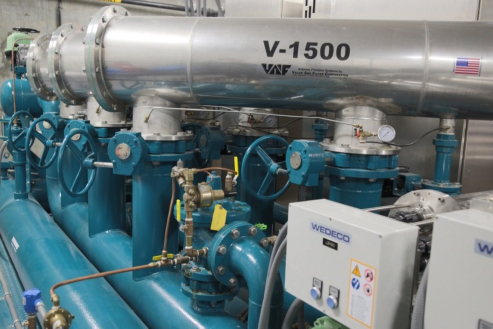
TABLE 6-6 Influent and Effluent Fecal Coliform Levels for Stormwater Controls (data from the International BMP Database)
| Stormwater Control | Events Represented | Geometric Mean (MPN/100 mL) | Median (MPN/100 mL) | ||
| Influent | Effluent | Influent | Effluent | ||
| Bioretention | 27-30 | 3,355 | 886 | 5,000 | 750 |
| Grass-lined detention basins | 162-165 | 2,218 | 639 | 2,497 | 700 |
| Disinfection systems | 64-80 | 1,158 | 17 | 1,050 | 10 |
| Sand filters | 150-157 | 1,463 | 632 | 1,600 | 593 |
| Wet detention ponds | 23-24 | 2,930 | 637 | 3,200 | 1,500 |
NOTE: Data derived from the International Best Management Practice Database (www.bmpdatabase.org).
SOURCE: Clary et al. (2014).
Design methodologies and treatment trains for large-scale, urban, runoff recharge systems are lacking.
Household-scale Groundwater Recharge: Rain Gardens
Capture, Storage, and Infiltration. At the household scale, rain gardens are simple excavations that are 1- to 2-feet (0.3-0.6 meters) deep and sized to be about 10 to 20 percent of the roof drainage area with minimal subsurface preparation (see Figures 6-12 and 6-13). Specific site conditions including climate, rainfall intensity and frequency, and soil infiltration, will result in other production functions for other locations. As runoff enters the rain gardens, it infiltrates the underlying soil. If the entering runoff rate exceeds the infiltration rate, then the water ponds and is stored for later infiltration when the incoming runoff rate decreases. If the ponding becomes deep, then it can overflow through a surface outlet. Rain gardens are planted with vegetation selected to withstand the highly variable dry to submerged conditions.
Rain gardens are popular on-site controls that have low costs and can significantly reduce the discharges of roof runoff from homes. If designed correctly, then almost all of the roof runoff can infiltrate into the shallow groundwater with little runoff overflowing to the drainage system. Additional impervious surfaces may also drain to simple rain gardens, including walkways and driveways. Some of the considerations in the planning and design of rain gardens include the soil characteristics and depth to groundwater. The rate of infiltration limits rain garden use in poorly draining soils, as does the presence of a high groundwater table. In most cases, only a small percentage of the incoming water is lost through evapotranspiration (usually less than 10 percent) because of
the large amount of water applied to a relatively small area (Pitt et al., 2014). Long-term care is required to maintain the plants and to ensure the rain garden’s objectives.
Treatment. No additional treatment is typically provided for rain gardens at the household scale. Source control is used to limit stormwater collection to source areas with low contaminant levels. In cold climates, care needs to be taken to divert runoff from sidewalks or driveways that contains deicing salts from reaching the rain gardens (discussed further in the next section).
Neighborhood-Scale Groundwater Recharge: Biofilters
Capture, Storage, and Infiltration. Neighborhood-scale infiltration areas can be designed to collect and infiltrate mixed stormwater from several homes or buildings. They are more sophisticated than simple rain gardens because their engineered soils provide much greater infiltration rates over smaller sizes than rain gardens, while maintaining hydraulic conductivity over long periods. Assuming adequate underlying infiltration rates, almost complete runoff can be captured and infiltrated if sized correctly (generally about 2 percent or more of the paved drainage area). Sometimes biofilters incorporate subsurface storage tanks for beneficial use (Figure 6-14). Large facilities have also been incorporated into neighborhood parks and public gardens serving a several block area, especially when constructed in conjunction with other stormwater control elements (such as grass filtering swales and storage tanks) forming an effective treatment train. The biggest challenge when retrofitting these facilities is having adequate space to locate the biofilter in areas where the water can flow by gravity.
The performance of a biofilter is based on several key factors, including the size of the device, the inflow, the soil infiltration rate, the infiltration rate any engineered media fill used, the amount of subsurface storage (either in rock fill or structural storage), and the outlet structures. With excessive particulate solids loadings resulting in accumulations between 10 and 25 kilograms per square meter, infiltration rates can significantly decline, which results in nuisance and public health concerns associated with frequent and long-duration standing water. A biofilter with healthy plants can help sustain the infiltration rates at a desired level unless the accumulative particulate load occurs in just a few years, as can occur in biofilters that are not sized appropriately (Clark, 2000; Clark and Pitt, 2009). Pretreatment components, such as grass filters or swales, can also help reduce sediment-loading problems (Nara et al., 2006). An elevated sodium adsorption ratio, which may occur when deicing salts enter a biofilter with snowmelt, can also severely restrict infiltration capacity by causing dispersion of clays in a soil (Figure 6-15). To prevent groundwater contamination and premature clogging in biofilters with even small amounts of clay in the soil, high-salt-content water must be diverted from the infiltration facility.
Treatment. Biofilters rely upon soil treatment, sometimes amended with engineered media, to provide treatment of the percolating stormwater to decrease the groundwater contamination potential. Considerable literature exists on the capacity of biofilters, swales, and filter strips to capture contaminants
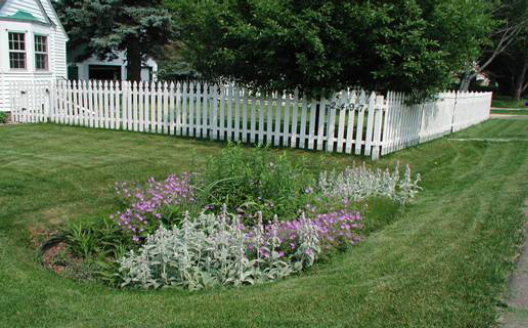
on soil or infiltration media for household or neighborhood-scale projects (e.g., Barraud et al., 1999; Dierkes and Geiger, 1999; Payne et al., 2015; Regnery et al., 2013; Weiss et al., 2008). Pollutants most likely to be removed during infiltration are metals or organic chemicals that sorb to soil or suspended solids, which are then removed by physical straining by the soil media, or biodegradable organic chemicals. In studies on recharge basins receiving large metal loads, the removal of most of the heavy metals occurred in either the basin sediment or the unsaturated zone (Hampson, 1986; Ku and Simmons, 1986). Metals can also be removed by surfacecomplexation reactions with oxide minerals such as ferric oxide (Appleyard, 1993; Dzombak and Morel, 1990). Organic compounds in urban runoff from oils and gasoline have a high affinity for organic solids and surfaces. Optimal siting conditions include deep soils containing moderate amounts of organic content for enhanced pollutant removal. The potential for contamination increases in areas with well-drained soils, typically sands with low organic content. In addition to sorption, organic compounds may also be removed through volatilization or biotransformation.
Physical straining through the soil or engineered media may remove pathogens, which are typically associated with particles, although the effectiveness will depend on the organism and the porous media properties. Straining is more effective for protozoan pathogens (greater than 3 microns), such as Giardia lamblia and Cryptosporidium parvum, and larger bacteria (approximately 1-2 microns) than for viruses, which are too small (0.02-0.08 microns) to be effectively removed by filtration through porous media, although adsorption to some types of subsurface media does occur.
Contamination potential is highest in areas where the permeability is very high or the water table is shallow. Examples from the Midwest suggest that infiltration rates should be small enough to allow for soil treatment of contaminants but high enough to ensure that the ponded water remains oxygenated. Published criteria for infiltration include rates that are greater than 0.2 in/hr (0.5 cm/hr),4 but less than 5 in/hr (13 cm/hr).5 States typically recommend that biofilters are sited between 2 and 5 feet (0.6-1.5 meters) above the seasonal high water table (Clark et al., 2010), although these values are generally derived from septic tank designs and may not be adequately protective of groundwater under a range of soil types and stormwater qualities. These design criteria also do not differentiate based on intended use of the groundwater, such as for drinking water supply.
Maintenance. Maintenance of biofilters includes periodic inspections to ensure proper drainage and removal of accumulated fine sediments as needed. Periodic sediment removal in the upper soil layer (50 cm or less) can also help avoid breakthrough of metals (Nieber et al., 2010). Care of plants (and replacement as needed) is important to maintain effective drainage rates.
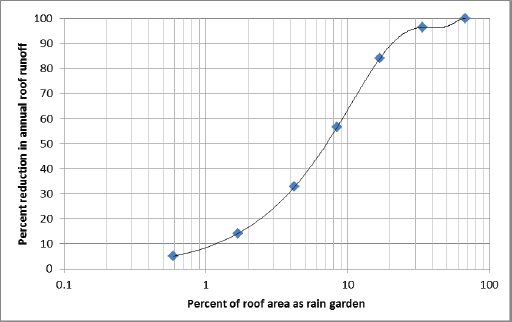
__________________
4 See http://www.pca.state.mn.us/index.php/water/water-types-and-programs/stormwater/stormwater-management/minnesotas-stormwater-manual.html.
5 See http://dnr.wi.gov/topic/stormwater/standards/postconst_standards.html.
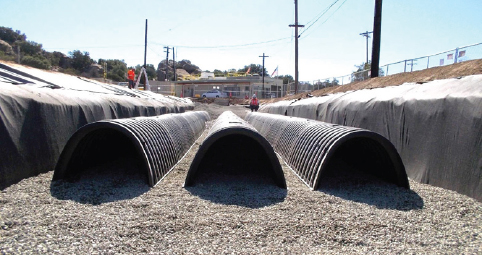
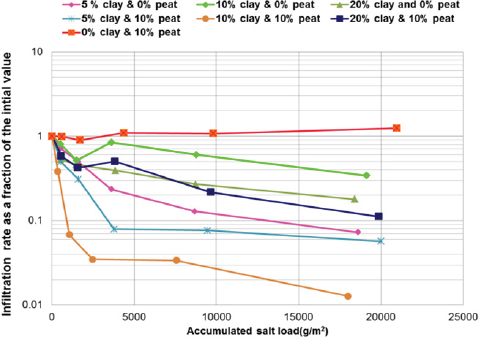
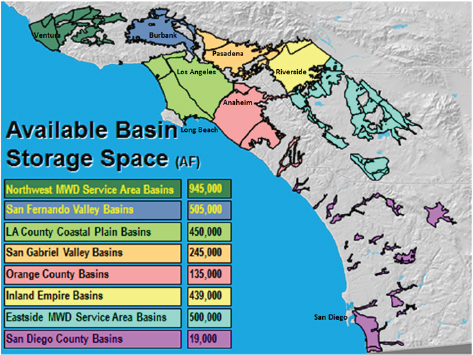
Regional Groundwater Recharge Projects
Capture, Storage, and Infiltration. Large-scale stormwater capture projects (Figure 2-1) are designed to recharge regional aquifers for future withdrawal to augment the local water supply. This can be accomplished through riverbank infiltration systems or infiltration basins in areas that recharge aquifers developed as water supplies. It is also possible to capture the stormwater in surface impoundments that are integral components of the water supply system. Regional-scale stormwater capture facilities are common in the arid Southwest of the United States, where for decades, water suppliers and flood control agencies have been capturing floodwaters in spreading basins both to replenish groundwater basins and to manage flood risk, while monitoring stormwater for water contamination. For example, in Southern California many groundwater recharge spreading ponds and other stormwater capture facilities (e.g., inflatable rubber dams) have been built as a part of the river flood control facilities to enhance percolation of stormwater (or flood water).
The geology and soil types are critical to identifying the best sites for recharge facilities. For example, Figure 6-16 shows the variability in aquifer storage in Southern California. Near San Diego, the hydrogeological conditions (fractured crystalline and semi-consolidated sedimentary rock) create mostly brackish aquifers with limited yield and storage. Stormwater storage options are limited to alluvial aquifers in San Diego. In contrast, the Los Angeles region has several large basins with vast storage capacity, although existing water contamination in some basins creates additional water management challenges.
Regional infiltration systems are designed to achieve and sustain maximum infiltration, with periodic maintenance to remove sediment that reduces infiltration rates. Water conveyance systems within the drainage basin and recharge basins are constructed and managed to optimize infiltration (see Box 6-5). Topography to support flow to locations at the bottom of localized or regional watersheds where sufficient space for recharge is also available are key siting considerations.
Treatment. As with biofilters, discussed previously, water treatment for large stormwater infiltration systems is typically provided by soil aquifer treatment, sometimes amended with engineered media to enhance contaminant removal. In current practice, no standard design criteria exist for stormwater treatment for large groundwater infiltration projects. At the spreading basins managed by the County of Los Angeles, no additional treatment is provided beyond soil aquifer treatment, but during a storm event operators monitor total suspended solids (TSS) and allow stormwater TSS greater than 500 mg/L to bypass the facility rather than divert it into the spreading grounds. Consequently, the so-called first flush (which is expected to contain the highest pollutant levels) bypasses the spreading grounds (MWH, 2003). In addition to protecting the water quality, this practice reduces the sediment load in the basins, thereby helping to sustain high infiltration rates. In Los Angeles, a stormwater recharge project in the Sun Valley neighborhood was designed to remedy flooding and provide beneficial use of stormwater from a highly urbanized area while ensuring protection of groundwater. The project incorporates hydrodynamic (swirl-type) separators with a media filter designed to treat the first flush, thereby removing suspended solids, oil, and heavy metals (CH2M-Hill, 2006).
Hatt et al. (2006) review treatment practices employed in Australia for use of urban stormwater for nonpotable purposes. They conclude that practice is ahead of research, with no technologies designed specifically for stormwater use. Rather, standard technologies designed for general stormwater pollution control (e.g., sediment traps, swales and buffers, wetlands and ponds) are employed. The authors make the case that the absence of specific guidelines will limit stormwater use to smaller scale, less complex systems.
Maintenance and Operations. Maintenance strategies at large stormwater recharge facilities are largely concerned with maintaining high infiltration rates, which consists of managing both sediment and ponding duration in the basins. Techniques to manage stormwater infiltration basins to sustain performance are discussed in the Australian Guidelines for Water Recycling—Managed Aquifer Recharge (Australian SCEW, 2009) and in Kazner et al. (2012). Regarding sediment management, facility operators aim to minimize the accumulation of fine particulates in the surface layers of the spreading grounds, which decreases the soil’s hydraulic conductivity and, consequently, infiltration rates. Maintenance activities include occasionally removing surficial soil layers and mechanically ripping the basin soil to break up any clogging layers (Chambers Group, 2014; MWH, 2003). Facility operators manage ponding duration to control groundwater mounding, which decreases the pressure differential within the vadose zone, thereby decreasing infiltration rates. Ponding management also helps avoid potential vector concerns associated with standing water. Ponding management consists of allowing basins to sufficiently dry between wetting events; to that end, when possible, operators use a battery of infiltration basins to regulate the specific placement of water at the facility to leave some basins empty long enough to properly dry (Batman, Los Angeles County Department of Public Works, personal communication, 2014).
SYSTEMS THAT INTEGRATE STORMWATER AND GRAYWATER USE
Integration of the beneficial use of stormwater and graywater can offer many advantages including achieving larger reduction in water use compared to when either approach is used alone. In particular for irrigation applications, stormwater can help to flush salts that may accumulate in graywater-irrigated soil. Below is a list of some of the possible configurations of integrated graywater and stormwater systems:
- Graywater and stormwater are used for irrigation
- Graywater is treated for toilet flushing, and stormwater is used for irrigation and/or supplementing indoor nonpotable uses as needed
- Graywater is used for irrigation, and stormwater is used for indoor nonpotable use and to supplement graywater irrigation as available
There are some important design considerations for systems that integrate graywater and stormwater. Sizing of combined systems needs to account for the complexities of the variable nature of the stormwater flows, the fairly consistent supply of graywater, and the demand profile for use. Given this complexity, it may be necessary to conduct continuous simulation of these systems to determine appropriate sizing and control logic. Integrated systems may be most advantageous in combined sewer areas where potential overflow of graywater combined with stormwater does not have direct negative impacts on receiving waters. In Mediterranean climates, integrated systems could potentially provide stormwater storage during the wet season and graywater storage during dry months. To avoid septic conditions, untreated graywater should not be stored for more than 48 hours. Most stormwater storage tanks are designed to store water for long durations to maximize water supply, but raw graywater should not be combined with stormwater in storage tanks that have storage times longer than 48 hours. If graywater is treated to remove a substantial portion of organic matter, then it could be combined with stormwater for longer duration storage. Also important to consider in the design of integrated stormwater and graywater use systems is that the treatment required for each source of water is different for different uses. Therefore, to maximize treatment efficiency, graywater and stormwater may need to undergo treatment through separate processes or process trains. For example, graywater used to flush toilets may be treated through a series of filters and membranes to reduce organic content, while stormwater supplemented to graywater for toilet supply may be treated through a simple sand filter. The combined waters would then be disinfected prior to supply to toilets. In such a system, it would also be possible for stormwater to be treated through the same treatment train that is used to treat graywater, although that level of treatment provided would not be required for use in toilet flushing.
UNIT TREATMENT PROCESSES
Depending on the water quality objectives, the treatment processes may be similar for graywater and stormwater. Figures 6-5 and 6-8 present conceptual treatment systems for graywater and stormwater, respectively, for a variety of end uses and regulatory conditions. Based on the appropriate treatment system and desired water quality for the end use, unit processes can be selected. Because of a lack of national guidance for graywater and stormwater use and the wide variability of local regulations (see Table 6-4 and Chapter 8), no standard of practice shapes the design of treatment systems.
Table 6-7 summarizes applicable unit processes, organized by contaminant class that can be easily paired with treatment system designs as described in Figures 6-5 and 6-8. In some cases, unit processes that are typically applied for water and wastewater treatment but have potential to be applied to graywater or stormwater treatment are included. The most appropriate configuration of these unit processes will develop through lessons learned from current and future projects.
Unit treatment process efficiency and considerations specific to applications for graywater treatment are summarized in Table 6-8. Similar information for application of these unit processes to stormwater can be found in Strecker et al. (2005) and Clark and Pitt (2012). In addition, a summary of commercially available graywater treatment systems can be found in Sharvelle et al. (2013). Stormwater control practices are usually built as part of the drainage system, but some commercial treatment units (especially media filters and hydrodynamic separators) are available. A NRC report (2009d) summarized many stormwater control options, along with features and expected performance. Pitt et al. (2011) describe some off-the-shelf treatment systems that have been used for roof runoff capture at the household scale, along with case study descriptions of stormwater treatment systems that have been used for larger-scale stormwater beneficial use applications.
CONCLUSIONS
Graywater irrigation at the household scale can be achieved with simple systems that require little energy and maintenance. These simple systems, such as the laundry-to-landscape system or systems that include storage, coarse filtration, and pumps, typically do not include organic matter removal or disinfection, and risk is managed through a series
of best management practices. However, there is a lack of clarity on the appropriateness of surface drip irrigation with no landscape cover, because the risk of this practice remains poorly defined at the household scale. Most guidance recommends subsurface irrigation as a conservative strategy. Neighborhood-scale systems typically provide disinfection where access-control is not feasible, which creates more system complexity and requires more energy, although the burden of maintenance is removed from individual homeowners. However, there is not yet a standard of practice for implementation of such neighborhood-scale systems, and many questions remain on who would implement, pay for, and maintain such systems.
Graywater reuse for toilet flushing requires plumbing components and treatment systems that are most appropriate in multi-residential buildings or neighborhoods. Graywater systems for toilet flushing require dual plumbing with a connection to potable water and backflow preventers that require annual inspection. Treatment systems for toilet flushing should include disinfection to reduce risk and prevent bacterial growth, and existing technologies are available. Even the simplest treatment systems require periodic maintenance that can be a burden at the household level, although such maintenance is more easily managed by contractors or on-site staff at the neighborhood/multi-residential scale. For broader adoption of graywater for toilet flushing at the house-
TABLE 6-7 Unit Processes to Achieve Removal of Target Constituents Described in Figures 6-5 and 6-8
| Particulate Matter | Capital Cost | Maint. Required | Energy | Applicability | Appropriate Scale | Regional | ||
| Graywater | Stormwater | Household | Neighborhood | |||||
| Diameter > 5-10 µm | ||||||||
| Sedimentation | low | low | none | |||||
| Diameter 1-5 µm | ||||||||
| Cartridge filtration | medium | medium | low | |||||
| Sand or soil filtration | medium | low | medium | |||||
| Diameter < 1 µm | ||||||||
| Membrane filtration | medium | medium | high | |||||
| Coagulationa | medium | high | medium | |||||
| DOC | ||||||||
| Biological aerated filters | medium | high | high | |||||
| Sequencing batch reactors | medium | medium | high | |||||
| Membrane bioreactors | high | medium | high | |||||
| Constructed wetland | medium | medium | low | |||||
| Soil aquifer treatment | medium | low | low | |||||
| Sand and soil filtration | medium | low | medium | |||||
| Membrane filtration | medium | medium | high | |||||
| Activated carbon | medium | medium | medium | |||||
| Pathogens | ||||||||
| Chlorine | low | low | low | |||||
| UV | medium | high | high | |||||
| Ozonationb | medium | medium | medium | |||||
| Membrane filtrationb | medium | medium | high | |||||
| Inorganic and Organic Contaminants | ||||||||
| Metals | ||||||||
| Chemically-active media filtration | high | medium | low | |||||
| Sedimentation | medium | medium | low | |||||
| Organic Compounds | ||||||||
| Air stripping (active) | medium | medium | high | |||||
| Chemically-active filtration | high | medium | low | |||||
| Sedimentation | medium | medium | low | |||||
aCoagulation has rarely been used with stormwater, but it can be effective.
bThese disinfection processes are possible with stormwater, but they have been rarely used.
NOTES: These unit processes are not stand alone and should be used in treatment systems as shown in Figures 6-5 and 6-8.
hold scale, treatment systems are needed that are low maintenance and include process automation and control to ensure safe use at a reasonable cost.
Many state graywater treatment standards for toilet flushing are not risk-based or fit-for-purpose. Many graywater quality standards are based on state standards for unrestricted urban use of treated wastewater, discharge of treated wastewater to water bodies, or other standards for very different applications than use of graywater for toilet flushing. Many of the standards for graywater use for toilet flushing may be unnecessarily strict in terms of organic content and turbidity removal, resulting in requirements for technologies that are costly, energy-intensive, and require frequent maintenance. Standards also vary widely across states, resulting in an inconsistency in treatment systems that can be applied. As a result, graywater systems are more costly than they might be otherwise, because a single standard of practice has not been established across the country, and treatment system manufacturers must develop systems to meet varying objectives. Additional research is needed to determine appropriate design standards for dissolved organic carbon and turbidity that prevent aesthetic and maintenance issues while allowing proper function of disinfection systems when using graywater for toilet flushing.
New developments and future urban planning provide opportunities for rethinking the conveyance and use of various water and waste streams for maximum cost, energy, and water savings. Separation of graywater results in blackwater that is more concentrated in solids and organic matter than conventional domestic wastewater and may be amenable to produce methane biogas through anaerobic digestion. These systems can also be integrated with urine sepa-
TABLE 6-8 Summary of Unit Process Application to Graywater
| Graywater Treatment Efficiency | Considerations Specific to Graywater Use | |
| Particulate Matter | ||
| Diameter > 5-10 µm | ||
| Sedimentation | Not well documented | No specific graywater considerations |
| Diameter 1-5 µm | ||
| Cartridge filtration | Highly variable depending on filter size | Clogging noted in filters smaller than 100 µm (pre-treatment required)a |
| Sand or soil filtration | TSS: 62-85%b,c,d | Several successful applications, good fit technology |
| Turbidity: 46-87%b,c | ||
| Diameter < 1 µm | ||
| Membrane filtration | Turbidity: 92-97% (UF), 98% (NF)e | Potential for fouling is high, but can be reduced with extensive pretreatment |
| TSS: 100% (NF)e | ||
| Coagulation | Turbidity: 82-91%f | None |
| DOC | ||
| Biological aerated filters | Effluent BOD < 20 mg/Lg | No specific graywater considerations |
| Sequencing batch reactors | Effluent BOD < 20 mg/Lg | No specific graywater considerations |
| Membrane bioreactors | Effluent BOD < 4 mg/Lg | No specific graywater considerations |
| Constructed wetland | Effluent BOD 0.7-80 mg/Lg | No specific graywater considerations |
| Soil Aquifer treatment | Not Applicable | Not Applicable |
| Sand filtration | Effluent BOD 62 mg/Lb | Several successful applications, good fit technology |
| COD: 37-61%b,c,d | ||
| Membrane filtration | Effluent BOD 86 mg/L (UF),h 1.5 mg/L (RO)h | Potential for fouling is high, but can be reduced with extensive pretreatment |
| COD: 45-96% (UF), 93% (NF), 98% (RO)e,h | Due to low molecular weight of graywater DOC, NF or RO is needed for efficient removale | |
| Activated carbon | Effluent BOD 10 mg/Lh | No specific graywater considerations |
| COD: 93%h | ||
| Chemical oxidation | Not Applicable | Removal of organic matter negligible when ozone generator was sized practically for residential or multi-residential applicationsi |
| Photo-oxidation | Not Applicable | Graywater DOC (mostly surfactants) results in high turbidity, photo-oxidation is not effectivei |
| Bacteria and Viruses | ||
| Chlorine/Bromine | Depends on dose and initial water quality | Effective and low costi |
| Not good for plants in irrigation application | ||
| UV | Can be effectivek | |
| Ozonation | Safety concerns at residential scale | |
| Hydrogen peroxide | Corrosive to toilet componentsj | |
aE. Clerico, Natural Systems Utilities, personal communication, 2014.
ration including nutrient capture. Thus, graywater reuse can be a key element of energy-efficient urban water and resource management systems that not only minimize net water abstraction from the environment but also achieve a high level of energy and nutrient recovery.
The state of practice and development of cost effective and safe stormwater capture systems for roof runoff are hindered by the lack of data on human pathogens and the risk associated with various uses. Design and treatment standards are generally well accepted for nonpotable use of runoff collected from land surfaces, and no treatment other than coarse solids removal is needed for subsurface irrigation where human exposures are minimal. For beneficial uses of roof runoff with low to moderate exposures, additional pathogen data and risk analyses are needed to establish a consistent state of practice for on-site stormwater use. Collection, storage, and treatment technologies are mature and can be readily adapted for various scales and uses, but appropriate guidance based on risk assessments is generally lacking.
Operations and maintenance of household and neighborhood graywater and stormwater use systems is not well guided or monitored. All systems that capture graywater and stormwater for beneficial use require routine maintenance. For systems where disinfection is not required (e.g., subsurface irrigation), failure to conduct needed maintenance poses operational concerns but does not pose a significant risk for human health or environmental quality. However, for systems with disinfection processes to protect human health (i.e., systems for toilet flushing), ongoing maintenance is critical. Although many states require that installed systems meet certain water quality targets, ongoing monitoring is not required. More guidance is needed to ensure safe operations of graywater and stormwater treatment systems at household and neighborhood scales. Because frequent routine water quality analyses are expensive and impractical even at the neighborhood scale, system operational performance standards and online monitoring of surrogate parameters (e.g., residual chlorine, suspended solids, or turbidity) should be considered.
Stormwater infiltration for aquifer recharge is commonly practiced, but designs and regulations in the United States may not be adequately protective of groundwater quality. Design for large-scale stormwater infiltration projects are still emerging. For many locations, the design and performance standards for stormwater infiltration have been developed to address surface water regulatory drivers rather than the protection of groundwater quality from stormwater infiltration. Of particular concern is the infiltration of organic contaminants and salts from highly urbanized areas into water supply aquifers, although human pathogens may also be of concern depending on the infiltration site characteristics. In current practice, no standard design criteria exist for stormwater treatment for large groundwater infiltration projects. Thoughtful planning, source area selection, source control, and mechanisms to integrate treatment into the watershed could improve efficiency of these systems and reduce the amount of treatment required. Innovative treatment systems, for example, engineered wetlands and filter media, may also be needed for regional-scale systems where source control is challenging.



























